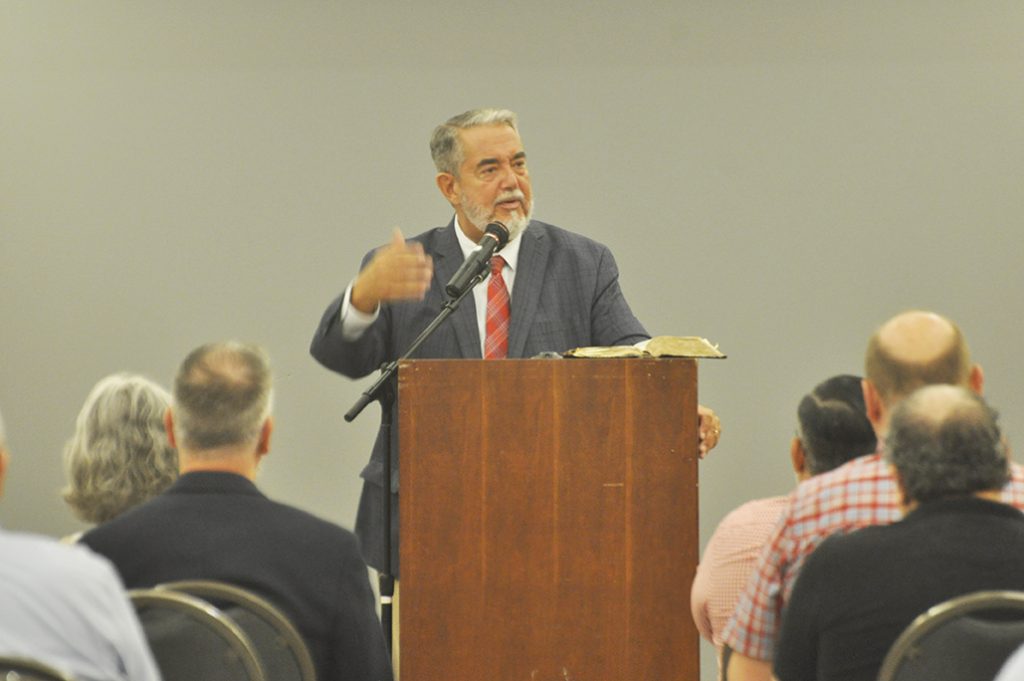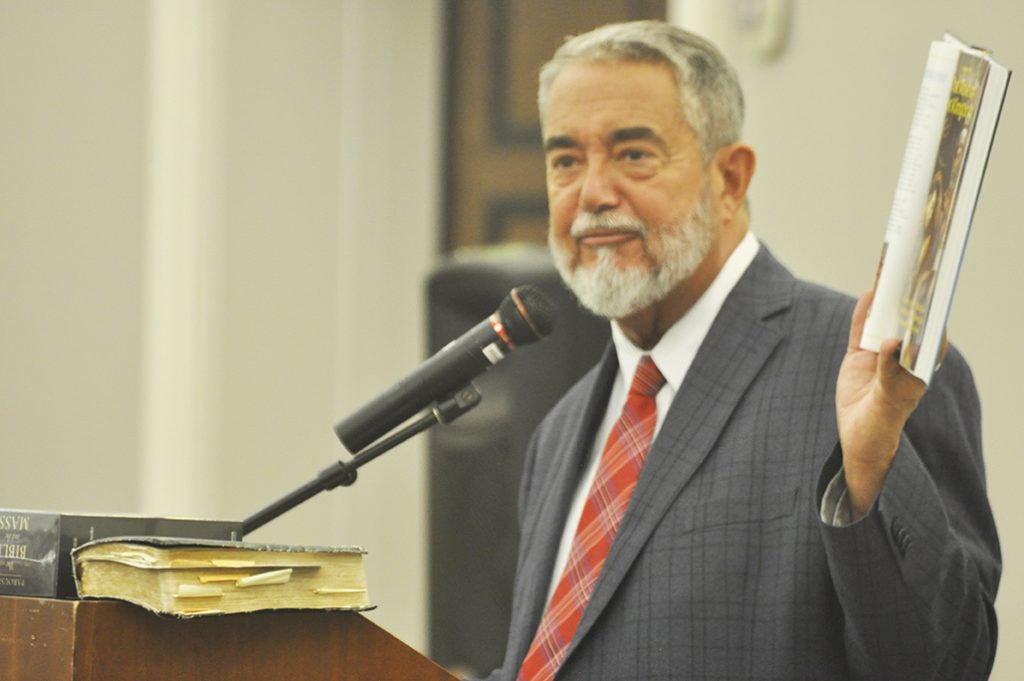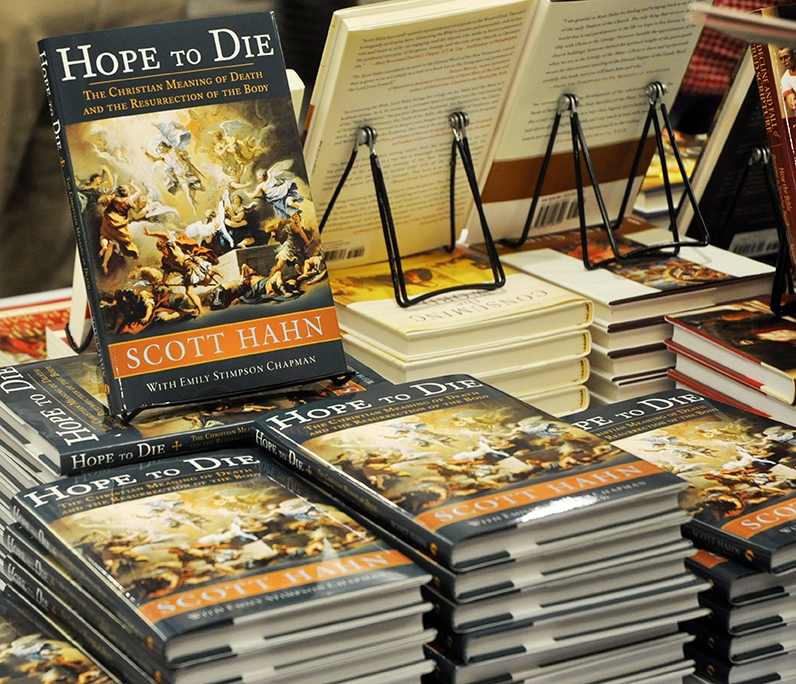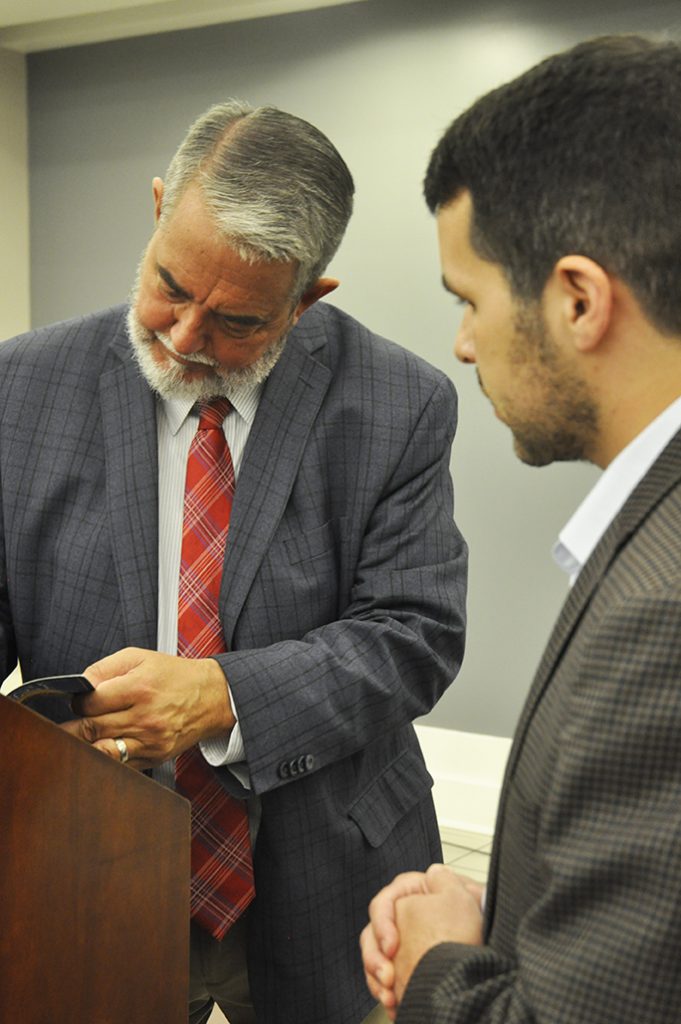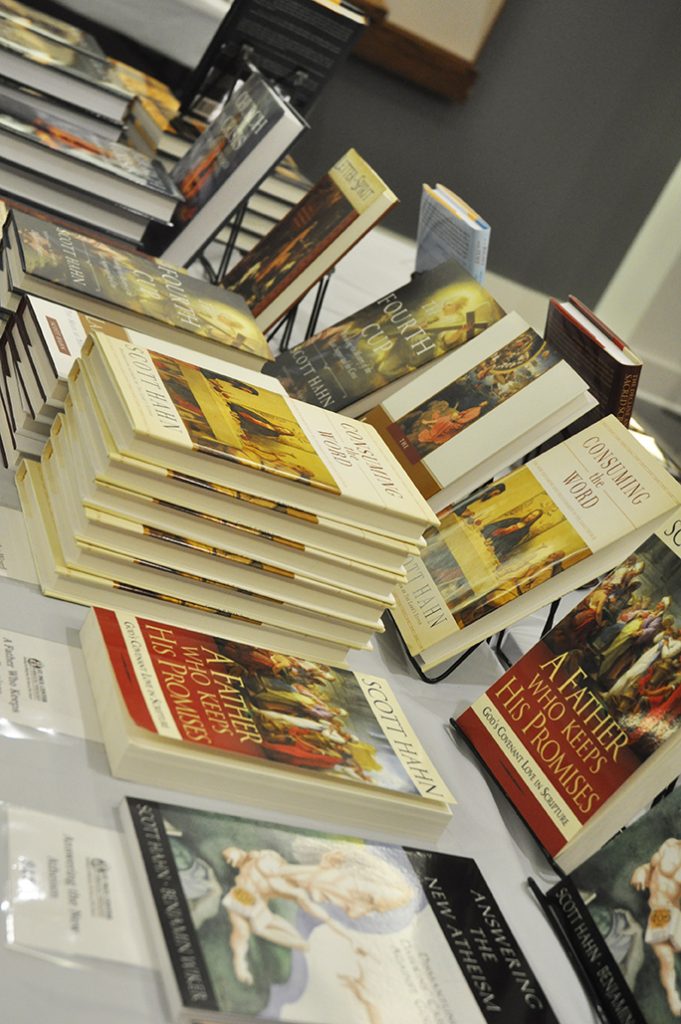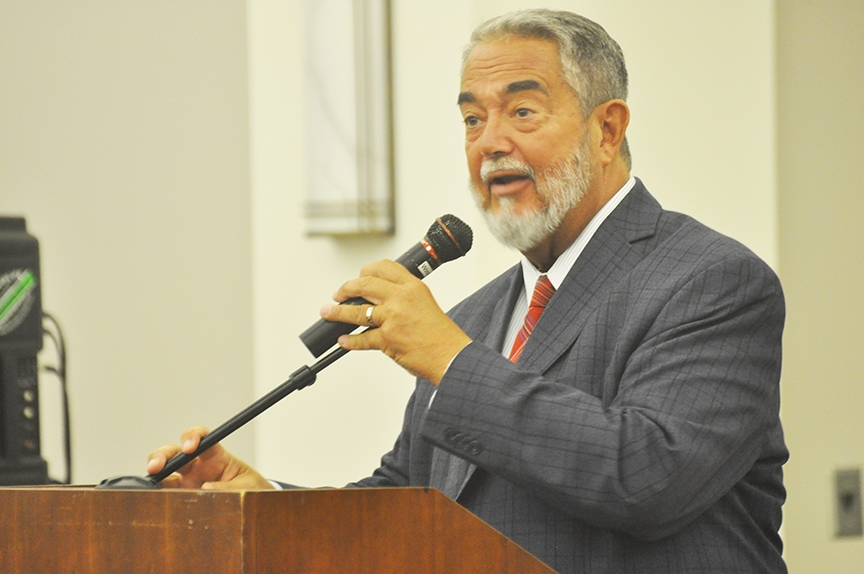
The truth and beauty of the Holy Sacrifice of the Mass, how it’s the fulfillment of Old Testament prophecy, and its connection to the promise of eternal life in heaven with God was the focus of Dr. Scott Hahn’s two-part presentation Saturday, Aug. 27, in the Fleming Center of the Cathedral of the Incarnation in Nashville.
Hahn is a best-selling author and speaker and is the founder and president of the St. Paul Center for Biblical Theology, “a nonprofit research and educational institute that promotes life-transforming Scripture study from the heart of the Church,” according to the official website. He is a former Protestant minister who converted to the Catholic faith, coming into the Church at the Easter Vigil in 1986.
The Road to Emmaus
As the presentation began, Hahn started with the story of the two companions on the Road to Emmaus, which starts at Luke 24:13. As he went through the story, he noted verse 16 immediately, which says, “their eyes were kept from recognizing him.”
“Remember that,” Hahn said. “This was something that our Lord himself chooses to withhold from them until the proper moment.”
Then, noting how Cleopas and his companion spent hours with Jesus on the journey, listening to him refer to the prophecies of scripture that pointed to the Messiah, it was only during the meal later, when Jesus took the bread, blessed it, broke it and gave it to them that “their eyes were opened.”
And it wasn’t because they experienced a sort of “déjà vu” from the events of Holy Thursday, as they were not among the 12 who were present, Hahn said.
“It’s something different,” he said. “It’s simply the moment that Our Lord has chosen freely and sovereignly to reveal his own resurrected body, blood, soul and divinity in the breaking of the Eucharistic bread.”
And the use of the phrase “their eyes were opened” was no coincidence either, Hahn said, as it is only the second time in scripture those words are used in that exact sequence.
The first is in Genesis 3 when Adam and Eve eat of the forbidden fruit. But this time, instead of eyes being opened to the shame and guilt that came from transgressing God’s law, “there is a new covenant and a new mediator, a new Adam,” Hahn said. “He chooses that it will be in the partaking of food where the covenant is kept and renewed that their eyes are going to be opened to the fulfillment of God’s plan.
“Afterwards, they could speak of how their hearts had been burning as he opened up the scriptures,” he added. “The scripture is opened first. Then, in the breaking of the bread, the eyes of faith are opened.
“This story that fell only in Luke’s Gospel becomes very influential and informative in the first generation of the Christian movement, and no wonder because it establishes the paradigm, the two-part model of what worship would consist of from then and there until here and now, in the holy sacrifice of the Mass,” Hahn said.
“As the scriptures are opened, we hear the promises of the old having been fulfilled by the Christ in the establishment of the new,” Hahn said. “But it’s not just there as the print on the page. It is the person of the son who comes to us when the father took, blessed, broke and gave.”
Waiting to open their eyes until the bread is offered “was for our sake, so we would recognize him in the breaking of the bread as they did,” Hahn said.
Continuing with the story, Hahn spoke of how this is done yet again later that evening after Cleopas and his companion found the 11 apostles and told them of the events of the day before Jesus stood before the gathered apostles and walked them through the prophecies of the Messiah yet again, so they too might understand, he said, proving that the old and the new testaments must come together.
“You almost need to read backwards because only in the light of Christ crucified and resurrected does suddenly the story make sense,” Hahn said. “Only when we come to a deeper understanding of sacred scripture, the law and the prophets, are we going to come to a much greater appreciation and stronger faith in not only his crucifixion and resurrection, but how what we profess to believe is the resurrected body, blood, soul and divinity of Christ.”
This body is the one in the same body that instituted the Eucharist on Holy Thursday, that hung on the cross on Good Friday, that was buried and laid in the tomb, that was resurrected and ascended and is now seated at the right hand of the Father in heaven, Hahn said.
From there, Hahn reiterated other elements of the Hebrew scripture that paralleled Christ, including God’s test of Abraham to sacrifice Isaac in the book of Genesis, the first Passover and Moses’ saving of God’s people from Pharaoh in Exodus, and more, showing that the sacrifice of Christ was not a Plan B, but the fulfillment of Plan A all along. And it began with the institution of the Eucharist on Holy Thursday.
“The key that unlocks the door to find the answer is to look at Calvary in light of what happened the night before. Celebrating the Passover one last time fulfilled the old by transforming the old into the new,” Hahn said. “Christ is the Lamb of God that lays down his life out of love for us.”
Therefore, the sacrifice is initiated on Holy Thursday, consummated on Good Friday, and offered up through the Resurrection on Easter Sunday, he said.
“Our eyes opened in the breaking of the Eucharistic bread because that’s who we are as New Testament Christians. We are Eucharistic Catholics,” Hahn concluded. “If we open ourselves to the grace of conversion, it will last a lifetime, but it can also be something we can experience every day” through the sacrifice of the Mass.
Hope to die, hope to rise
In the second part of Hahn’s presentation, he drew on his book, “Hope to Die: The Christian Meaning of Death and the Resurrection of the Body.”
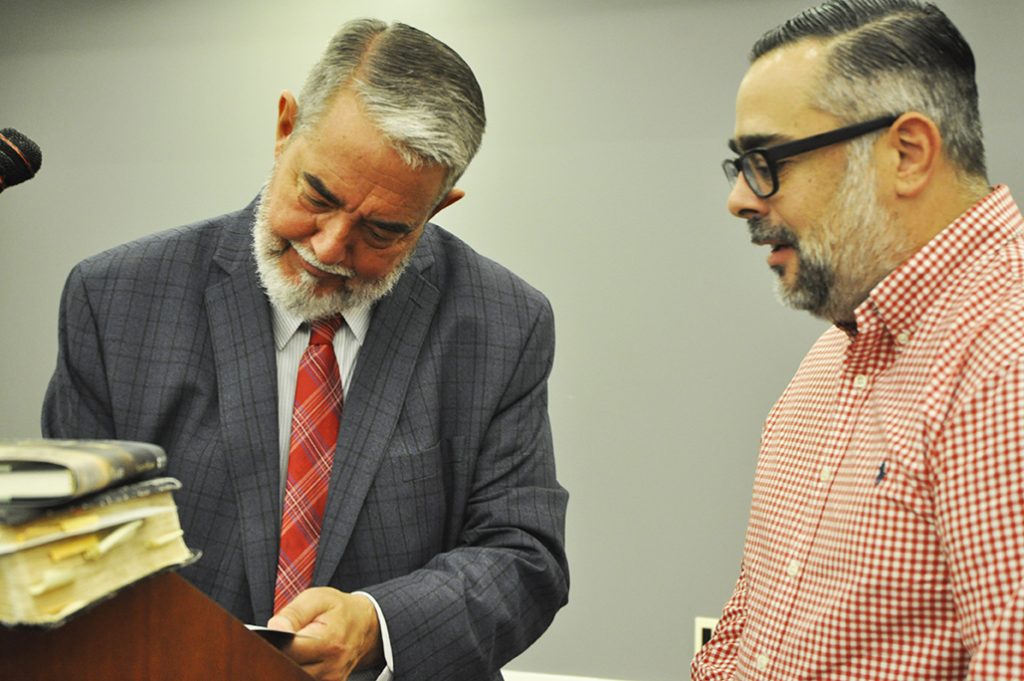
“I want to connect not only the Old Testament with the new, not only the document with the sacrament, but the resurrected body, blood soul and divinity of Christ in the Holy Eucharist to our own resurrected body, blood, soul, which will be divinized for all eternity,” Hahn explained. “It is the good news that we believe and profess as Catholics.”
To begin, Hahn explained how sacred the human body is, beginning with the creation of the first parents in Genesis.
“God created not just souls but bodies and not just souls that were trapped in bodies, but souls that are embodied as something essential to who we are as humans,” Hahn said. And in the case of the creation of Adam and Eve, those bodies were not just natural, but supernatural, not just human, but divine, because God “breathed into (Adam’s) nostrils the breath of life, and the man became a living being,” (Genesis 2:7).
But then, through the committing of original sin, that supernatural and divine element expired, causing not a death of the physical body, but the death of the soul, which happens “when you give consent to what you know to be grave sin,” or a mortal sin, according to 1 John 5:17, Hahn explained.
“They committed spiritual suicide. They snuffed out the life of God’s own spirit,” Hahn said. “It’s a far greater death and yet far more mysterious. …This is what we as Catholics understand original sin to mean.”
But not all is lost because that supernatural and divine element is restored in the waters of Baptism.
“Baptism is more than a washing or cleansing from the state of original sin,” Hahn said. “Baptism is what puts back into our soul what our first parents had but then lost – sanctifying grace.”
And this grace continues to be renewed through the sacraments including Reconciliation and the Eucharist.
“The sacrament of mercy, the sacrament of penance, is a divine medicine. God is not simply willing to forgive us and heal us of our physical illness and restore our natural life,” Hahn said. “He wants to restore a life that is eternal, divine and supernatural along with our natural bodies. He has given us that promise” through the sacrifice of Christ on Calvary, which didn’t promise to take away pain and suffering, but turns our pain and suffering into passion and makes our lives a living sacrifice, offering our trials up to him.
Additionally, by partaking in the sacrament of Holy Communion, “God takes our mortal flesh and unites it to his own resurrected body, blood, soul and divinity, so we’re united to him more perfectly in love and the power of the Holy Spirit,” Hahn continued. “He’s setting into motion something more than the fulfillment of the Old Testament by the new, something more than transubstantiating bread and wine into his body, blood, soul and divinity.
“He wants to transform sinners into saints, body and soul,” he said. “The Eucharist is the means by which we will get home. … The Eucharist, the Paschal Mystery, is what transforms suffering and pain into passion, making our lives a living sacrifice.
“God possesses all glory for all eternity. He wants to lavish that eternal life on us and make us the recipients and beneficiaries of something that we don’t have enough faith to ask him for,” Hahn concluded. “It’s all the seven sacraments that make us not just forgiven sinners, but truly sons and daughters of the most high, and it’s what calls us home to be saints.”
‘Scriptures come to life’
Hahn’s presentation, which was attended by more than 400 people, was met with a positive response.
“Dr. Hahn focuses on and has the ability to make the scriptures come to life unlike many of the other popular Catholic scholars that are putting out content today,” said Ray Cue, a parishioner of the Church of the Assumption in Germantown. “He also teaches with incredible joy and love and humor, and this really separates him from the rest whose teachings tend to be on the gloomier side of things in parallel with much of what is happening in the world today.”
Ryan Tremblay, a parishioner of Church of the Holy Rosary and a music teacher at Holy Rosary Academy, said several elements of Hahn’s presentations stood out to him, particularly keeping focus on the promise of eternal life.
“We are called to become lovers of eternal life. In so many ways, we can find ourselves fixated on the things of this world, and yet having an eternal perspective is what brings us true joy amidst any challenges we may face,” Tremblay said. “We must turn our pain into passion and seek redemptive suffering, offering it all up each step of the way, just as Jesus did.”
